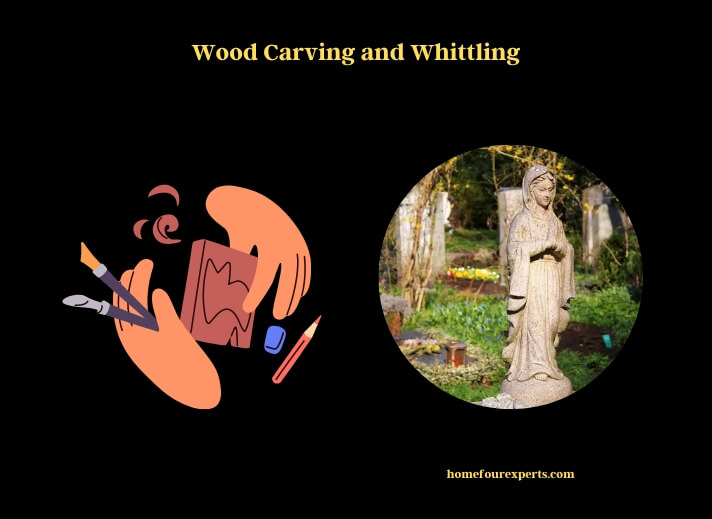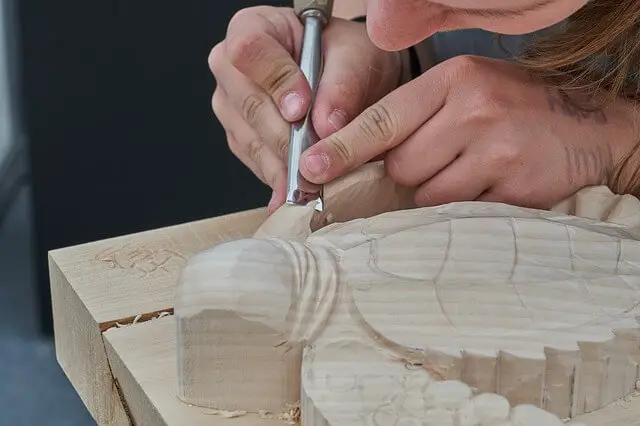Published on: August 6, 2022
Written by Eric Devin / Fact-checked by David Rowan
The differences between whittling and carving are formed differently from different perspectives. If we see these terms from different points, these seem similar at some point and become distinctive from another. However, this dilemma is clarified here. We tried to discuss all the aspects where whittling and carving considered different and similar.

To get a clear understanding, I suggest reading through the article without skipping any sentence. For a wood craftsman, whether he/she is a professional or beginner, the difference and similarities of wood wilting and crafting should be well acquired.
Differences of Whittling and Wood Carving
Sometimes, whittling and carving are different in different localities. Sometimes, it is merely the choice of tools while doing so. For some, it is just a title they like to call themselves. The reasons for a different understanding of whittling and carving are discussed here.
Tools Used
Mostly whittling and carving are differentiated considering the number of tools used. Any kind of woodworking is done with cutting tools. The variety of cutting tools is prioritized to make these terms differ from one another.

Tools Used for Whittling
Primarily, whittling is differentiated from carving by the knives used to do it. Practically, only one knife is enough to make an artful piece if one knows how to do it and has a lot of experience. A simple pocket knife and a piece of white wood are all you need to get started with whittling.
But the industry of whittling knives is a little broader than that. There are a few variations of knives that are good or bad for whittling. Pocket knives with several blades are better than a single blade to whittle. As different sizes of blades are useful to make different shapes and sizes of cuts. Read more: Whittling: What Tools does a Whittler Need?
Generally, blades with a downward head are preferred for whittling. Flexcut knives, sheep-foot blades, and high-quality pocket knives are good options for anyone who wants to master their wood whittling creativity.
Tools Used for Carving
Unlike whittling, carving can be done manually, or by machines. There are different tools used to give the art piece a smooth and fine finished look. So, it involves more tools other than just cutting wood.
Cutting knife, gouge, mallets, chisels, and chainsaw are basic carving tools. For more advanced woodworking, carving knives, bench knives, veiner, V-tool, riffler, skew or corner chisel, long bent tool, fishtail, short bent tool, sloyd knife are used. All these tools vary in size from small to big for different project sizes as well as cut sizes.
So, the wood carving tool is enriched with countless tools. To begin wood carving, a beginner’s pack of the basic assorted tool is enough. But for more mature work, all these tools are used to make the work outstanding.
Technical Differences
Needless to mention that, these carving tools I have mentioned above are used manually and time-consuming. So, electronic devices and accessories also become popular and nowadays widely used for wood carving. Rotary tools, scroll saws, reciprocating chisel holders, different sanding devices, and electric chain saws are used for small, medium, and large projects. Some prefer starting their work with manual tools and finish off using electric tools.
On the other hand, whitling is done manually from beginning to finishing. There is no room for electric devices. All it involves is a piece of wood and a small knife.
Local Terms
Wood carving is called whitling in many countries. For example, in America, whittling is referred to as curving wood with any tool one can use. It does not matter if it is a pocket knife or an army of tools: whittling is all they know about cutting wood to turn it into an art.
In some countries like Germany, people do not understand the term whittling. For them, it is all about carving wood. Even if the finished result is thoroughly unfinished, it will be called whittling. For example, vegetables or fruits are carved with a knife, still, we don’t call it fruit whittling, we call it fruit carving.
Profession
The woodworking industry has several subcategories. Some professionals just love to refer to themselves as whittlers, chip carver, letter carver, decorative carver or raffler, and so on. You see, as there are various stages of woodworking, people like to use these terms to indicate their level of expertise. For some, it is just their personal preference, no matter which tools they use or where they live.
On the other hand, if someone starts wood art, they will be called whittlers in America. No matter how timeless or beautiful the artwork is. If you are not a professional, selling art or teaching art in some institutions, you are a whittler, not a carver. Because American tradition has a long history of taking whittling as a hobby for elderly and summer camping. As it does not need much tool or money to start this hobby, this is widely popular throughout America. So, here, a man whittling outdoors or in summer camp is a common scenario.

Finishing of the Workpiece
If artwork has geometric shapes of cuts and scrapes all around, then it is acknowledged as a work of whittling. It is like rough drawing a subject with triangles and half-moon shapes.
Wood carving usually has a smoother and very detailed surface. It is like any other status made with mud, or stones.
How to Choose Wood for Whittling or Carving?
- Practically, any wood is suitable for carving or whittling. But there are differences in terms of ease and preference of wood we use for making a house, furniture, or art. Whitewoods like white pine, sugar pine, and basswood are soft and widely used for whittling.
- The piece of wood should be knot-free. If not possible to ensure then it is preferable that it will have minimal knots. Knots not only make the cutting difficult, but it also makes it look irregular.
- If the piece has wood grains in one direction, then it is the best to use for carving or whittling. Wood grains change their direction and the cutting direction also changes with those grains. So, a unidirectional wooden piece is a great resource for making wood art.
Can Wood Carving Techniques Be Used on Masonry Surfaces?
When it comes to carving techniques, wood sealer for masonry might not be the go-to solution. Wood carving techniques are specifically designed for wood surfaces, while masonry surfaces require a different set of tools and techniques. Using a wood sealer on masonry surfaces would not yield the desired results and may even affect the integrity of the material.
Which Tools Are Used for Wood Carving and Whittling?
Wood carving and whittling require specific tools to achieve intricate details and smooth finishes. One of the essential tools used in these crafts is types of woodworking chisels. These chisels, available in different shapes and sizes, allow woodworkers to gouge, shape, and sculpt the wood with precision. From a straight chisel for general tasks to a V-parting tool for creating grooves, the variety of woodworking chisels aids in bringing exquisite woodcarving and whittling creations to life.
What is the Secret of Artful Whittling and Carving?
Know Your Cuts
Of course, you must know what you are doing. Wilting may not require more than one tool, but its magic lies in the cuts. Stop cut, pull cut, push cut, V-cut are the most common cuts used in wilting. One needs to learn when and how to use these cuts to create a particular shape or design on a woodblock.
On the other hand, there might be countless tools in carving, but the usage of those tools is fixed. For successful carving, the knowledge of the usage of basic tools and lots of practice is what is needed. A large array of tools will come later if you can continue doing it or make a living out of it.
Make Small Cuts
Secondly, but the most important thing about wood carving is patience. You must have patience and work in smaller strokes to make a design flawless. Remember, you can make a big cut using several small cuts, but once a large chunk is accidentally cut, you can’t easily patch it together.
Cut Along the Grain Direction
The surface ew cut while cutting against the wood grain is far different from the cuts we make along the wood grain. A surface is smoother and seamless when it is cut along the wood grain. But it is common to work with a block that has grains in different directions. In that case, simply turn the block and change your cutting direction aligning the wood grain. With a sharp knife, you can cut against the grain, but the risk of mistakes is higher in this matter.
Sharp Knives and Tools
It is said that any wood is perfect for wilting and curving if the tools are right. So, learn to sharpen your tools and keep them sharp and ready. Never ever use a dull tool for wood carving. The risk of injury is higher in this case, as the risk of imperfect art.
Safety
Finally, when you have put on your safety gear, you can work with more confidence. And confidence shows in everything we do, including wood carving. Carving and wilting tools are very sharp, so, to work more comfortably without worrying about any injury, always wear your safety gear.
Final Verdict
Wood whittling and carving both are incredibly artful, popular, and well appreciated. An artist is able to make incredible art pieces just by using a small knife. On the other hand, an amateur may not be able to make an aesthetic piece even if they use all the tools they can get for carving.
So, if you are concerned about the acceptance of wood whittling or wood carving, then I would say that it is just a matter of skill. If you are able to learn using a knife, then maybe whittling can be a great field for exploring your abilities. Contrary, wood carving requires patience to learn using each tool, master the skills, and finally, a bigger budget and time to pursue it for a long period.
Related Posts:
About This Writer

Hi, I am Eric Devin and I am a professional interior architect. Since childhood, I've always enjoyed DIY projects! And, I have loved to solve simple household problems using essential tools and equipment. I have also acquired a lot of information about basic household tools settings by working with contractors.